The European plant-based milk industry is projected to grow from USD 4,380.0 million in 2025 to USD 10,464.6 million by 2035, advancing at a CAGR of 9.1%. The soy milk segment is expected to lead sales with a 38.0% share in 2025, while direct beverage consumption is anticipated to account for 60.0% of the application segment.
European Union plant-based milk sales are projected to grow from USD 4,380.0 million in 2025 to approximately USD 10,464.6 million by 2035, recording an absolute increase of USD 6,100.0 million over the forecast period. This translates into total growth of 139.3%, with demand forecast to expand at a compound annual growth rate (CAGR) of 9.1% between 2025 and 2035. The overall industry size is expected to grow by nearly 2.39X during the same period, supported by the accelerating shift toward plant-based diets, increasing lactose intolerance awareness, and developing applications across direct consumption, coffee/barista, and culinary segments throughout European operations.
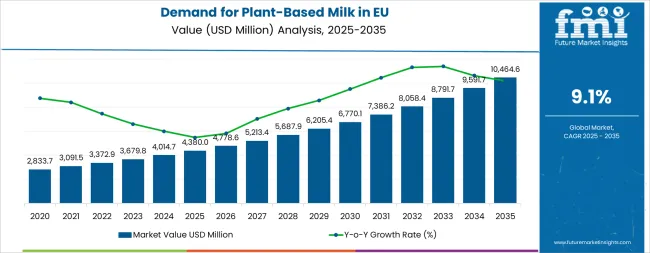
| Metric | Value |
|---|---|
| Industry Size (2025E) | USD 4,380.0 million |
| Industry Value (2035F) | USD 10,464.6 million |
| CAGR (2025 to 2035) | 9.1% |
Between 2025 and 2030, EU plant-based milk demand is projected to expand from USD 4,380.0 million to USD 6,776.1 million, resulting in a value increase of USD 2,396.1 million, which represents 39.3% of the total forecast growth for the decade. This phase of development will be shaped by rising consumer adoption of dairy alternatives, increasing availability of diverse product varieties, and growing mainstream acceptance of plant-based beverages across retail and foodservice channels. Manufacturers are expanding their product portfolios to address the evolving preferences for organic, fortified, and barista-grade formulations.
From 2030 to 2035, sales are forecast to grow from USD 6,776.1 million to USD 10,464.6 million, adding another USD 3,703.9 million, which constitutes 60.7% of the overall ten-year expansion. This period is expected to be characterized by further expansion of online retail channels, integration of advanced processing technologies for improved taste and texture, and development of specialized formulations for professional barista applications and culinary uses. The growing emphasis on environmental sustainability and increasing consumer willingness to pay premium prices for plant-based alternatives will drive demand for innovative plant-based milk products.
Between 2020 and 2025, EU plant-based milk sales experienced robust expansion at a CAGR of 8.6%, growing from USD 2,905.5 million to USD 4,380.0 million. This period was driven by increasing environmental consciousness among European consumers, raising awareness of lactose intolerance and dairy allergies, and rising recognition of plant-based nutrition benefits. The industry developed as major dairy companies and specialized plant-based brands recognized the commercial potential of dairy alternatives. Product innovations, improved taste profiles, and nutritional fortification began establishing consumer confidence and mainstream acceptance of plant-based milk products.
Industry expansion is being supported by the rapid increase in flexitarian and vegan consumers across European countries and the corresponding demand for sustainable, ethical, and health-conscious dairy alternatives with proven nutritional benefits. Modern consumers rely on plant-based milk as a direct replacement for dairy milk in beverages, cooking, and baking applications, driving demand for products that match or exceed dairy milk's functional properties, nutritional profiles, and taste characteristics. Even minor dietary concerns, such as lactose intolerance, dairy allergies, or environmental consciousness, can drive comprehensive adoption of plant-based milk to maintain optimal wellness and support sustainable consumption patterns.
The growing awareness of animal welfare issues and increasing recognition of dairy production's environmental impact are driving demand for plant-based alternatives from certified organic producers with appropriate sustainability credentials and ethical sourcing practices. Regulatory authorities are increasingly establishing clear guidelines for plant-based milk labeling, nutritional fortification standards, and quality requirements to maintain consumer safety and ensure product consistency. Scientific research studies and dietary analyses are providing evidence supporting plant-based milk's health benefits and environmental advantages, requiring specialized processing methods and standardized fortification protocols for essential nutrients, including calcium, vitamin D, and vitamin B12.
Sales are segmented by product type, application/use, distribution channel, nature, form, and country. By product type, demand is divided into soy milk, almond milk, oat milk, coconut milk, rice milk, and others. Based on application/use, sales are categorized into direct beverage, coffee/barista, culinary/processing, and other applications. In terms of distribution channel, demand is segmented into supermarkets/hypermarkets, convenience stores, online retail, and others. By nature, sales are classified into organic and conventional. By form, demand covers liquid and powder formats. Regionally, sales cover Germany, France, Italy, Spain, the Netherlands, and the Rest of Europe.
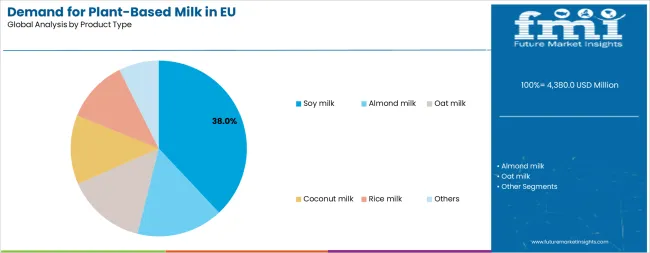
The soy milk segment is projected to account for 38.0% of EU plant-based milk sales in 2025, establishing itself as the dominant product variant across European operations. This commanding position is fundamentally supported by soy milk's long-established presence in European operations, comprehensive nutritional profile featuring high protein content comparable to dairy milk, and widespread consumer familiarity developed over decades of availability. The soy milk format delivers exceptional nutritional value, providing manufacturers and consumers with a complete protein source containing all essential amino acids, making it the preferred choice for health-conscious consumers, fitness enthusiasts, and individuals seeking dairy alternatives with equivalent nutritional benefits.
This segment benefits from mature supply chains, well-established production infrastructure, and extensive availability from multiple certified European and international suppliers who maintain rigorous quality standards and organic certifications. Additionally, soy milk offers versatility across various applications, including direct consumption, cooking, baking, and coffee preparation, supported by neutral flavor profiles in modern formulations that address historical concerns about taste.
However, the soy milk segment is projected to experience slight share erosion, declining to 36.0% by 2035 as newer alternatives, particularly oat milk and almond milk, capture incremental share through innovative product positioning and evolving consumer preferences.
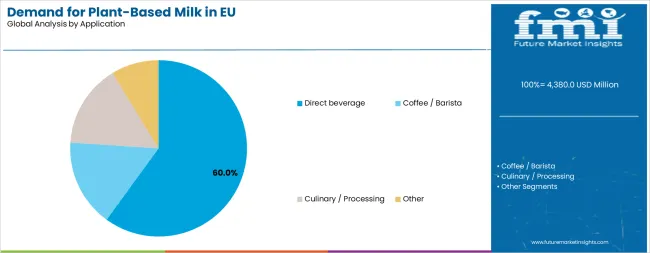
Direct beverage consumption is positioned to represent 60.0% of total plant-based milk demand across European operations in 2025, declining slightly to 58.0% by 2035, reflecting the segment's absolute dominance as the primary usage occasion within the overall industry ecosystem. This substantial share directly demonstrates that the overwhelming majority of plant-based milk purchases are for direct drinking occasions, including breakfast consumption, snacking occasions, and meal accompaniment, mirroring traditional dairy milk usage patterns.
Modern consumers increasingly view plant-based milk as a complete dairy replacement rather than a specialty ingredient, driving demand for products optimized for direct consumption with pleasant taste profiles, appropriate sweetness levels, and smooth textures that deliver satisfying drinking experiences. The segment benefits from continuous product innovation focused on taste improvement, with manufacturers investing heavily in formulation development to eliminate off-flavors, enhance creaminess, and create products that appeal to mainstream consumers beyond core vegan and lactose-intolerant demographics.
The slight share decline from 60.0% to 58.0% reflects faster growth in coffee/barista applications rather than absolute volume decline, as foodservice and specialty coffee segments expand more rapidly than direct consumption during the forecast period.
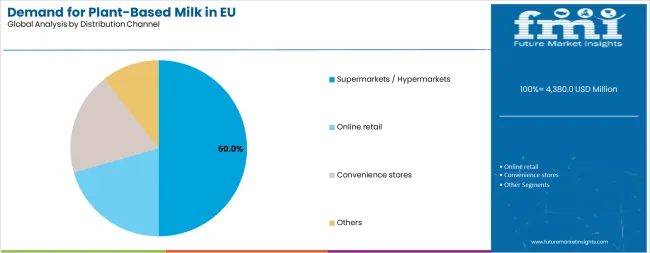
Supermarkets and hypermarkets are strategically estimated to control 50.0% of total European plant-based milk sales in 2025, declining to 45.0% by 2035, reflecting the critical importance of mainstream retail accessibility while acknowledging the rapid growth of alternative channels, particularly online retail. European consumers consistently demonstrate strong preferences for purchasing plant-based milk through traditional grocery channels that provide extensive product selection, competitive pricing, refrigerated storage, and convenient inclusion in regular shopping routines.
The segment provides essential mainstream visibility and accessibility that drives trial among curious consumers and supports regular repurchase among committed users. Major European supermarket chains, including Tesco, Carrefour, Edeka, Albert Heijn, and Mercadona, have systematically expanded plant-based milk shelf space, often dedicating entire sections to dairy alternatives and positioning them adjacent to traditional dairy milk to facilitate comparison and switching behavior.
However, the segment faces share pressure from rapidly growing online retail, which offers superior convenience, subscription options, and often better pricing for bulk purchases, particularly for shelf-stable formats and powder variants.
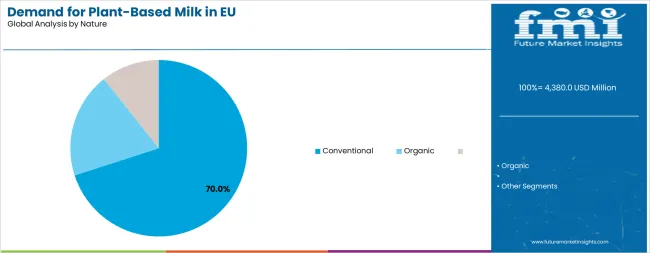
Conventional plant-based milk products are strategically positioned to contribute 70.0% of total European sales in 2025, declining slightly to 65.0% by 2035, representing products produced through standard agricultural methods without organic certification requirements. These conventional products successfully deliver accessible pricing and consistent quality while ensuring broad commercial availability across all retail channels and price points.
Conventional production serves price-conscious consumers, mainstream retail applications, and large-volume foodservice operations that prioritize affordability and consistent supply over organic certification. The segment derives significant competitive advantages from established international supply chains, economies of scale in processing, and the ability to meet substantial volume requirements from major retailers, coffee chains, and food manufacturers.
However, the segment experiences gradual share erosion as organic products capture incremental share, reflecting European consumers' increasing willingness to pay premium prices for certified organic plant-based milk. By 2035, the organic share is projected to reach 35.0%, up from 30.0% in 2025, reflecting strengthening consumer preferences for organic certification even as absolute conventional sales continue growing.
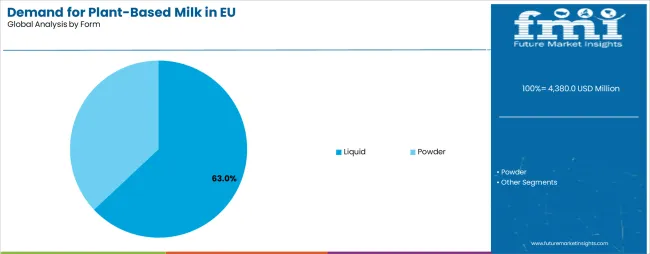
Liquid plant-based milk is positioned to represent 63.0% of total European sales in 2025, declining to 60.0% by 2035, reflecting consumers' strong preference for ready-to-consume formats that match traditional dairy milk usage patterns. Liquid formats dominate because they provide immediate usability, optimal taste and texture experiences, and seamless substitution for dairy milk across all applications, including drinking, cooking, and coffee preparation.
The segment includes both refrigerated and shelf-stable liquid formats, with refrigerated products typically commanding premium positioning due to perceived freshness and superior taste profiles, while shelf-stable formats offer convenience and extended storage capability. Liquid formats benefit from established distribution infrastructure for refrigerated products and consumer familiarity with traditional milk packaging formats.
The slight share decline reflects faster growth in powder formats, which appeal to specific use cases, including bulk purchasing, long-term storage, travel applications, and cost-conscious consumers willing to trade convenience for economic value.
EU plant-based milk sales are advancing rapidly due to accelerating flexitarian diet adoption, growing lactose intolerance awareness, and increasing environmental consciousness regarding dairy production impacts. However, the industry faces challenges, including taste and texture gaps compared to dairy milk for some consumers, higher price points that limit mass penetration, and nutritional concerns regarding protein content and fortification adequacy in some products. Sustainability messaging and continued product innovation remain central to industry development.
The rapidly accelerating development of specialized barista-grade formulations is fundamentally transforming plant-based milk positioning from a niche dairy alternative to a premium specialty coffee ingredient embraced by professional baristas and coffee enthusiasts. Advanced product formulations featuring optimized fat and protein ratios, enhanced heat stability, and superior foaming properties enable plant-based milk to deliver latte art quality and espresso flavor compatibility, matching or exceeding dairy milk performance in specialty coffee applications. These innovations prove particularly transformative in professional foodservice environments where barista endorsement and product performance directly influence consumer trial and adoption.
Major plant-based milk brands invest heavily in barista education programs, professional partnerships, and product development targeting specialty coffee segment requirements, recognizing that success in premium coffee applications creates halo effects supporting retail sales. Companies collaborate with coffee chains, barista training academies, and specialty roasters to position their products as preferred alternatives in professional environments, leveraging endorsements and visibility in premium coffee shops to build mainstream consumer awareness and trial.
Modern plant-based milk producers systematically incorporate advanced fortification strategies that address nutritional gaps compared to dairy milk, particularly calcium, vitamin D, vitamin B12, and, in some cases, protein enhancement. Strategic integration of bioavailable calcium sources, stable vitamin formulations, and fortification technologies that maintain product taste and appearance enables manufacturers to position plant-based milk as nutritionally equivalent or superior to dairy alternatives. These fortification capabilities prove essential for mainstream consumer adoption, as nutritional adequacy concerns represent significant barriers to switching from dairy milk, particularly among parents making purchasing decisions for families.
Product labels increasingly highlight fortification with "as much calcium as dairy milk" and similar claims that directly address substitution concerns and position plant-based milk as a complete dairy replacement rather than an inferior alternative. Manufacturers invest in clinical research, nutritional studies, and regulatory compliance supporting health claims that build consumer confidence in plant-based milk as nutritionally complete dairy alternatives.
European consumers increasingly prioritize environmental sustainability credentials when selecting plant-based milk products, with manufacturers responding through comprehensive lifecycle assessments, carbon footprint labeling, and transparent communication regarding water usage, land requirements, and greenhouse gas emissions compared to dairy production. Companies implement detailed sustainability measurement systems that document environmental advantages, enabling consumers to quantify their positive impact through plant-based milk selection. This trend proves particularly pronounced among younger demographics and urban consumers who view food choices as environmental statements and preferentially select brands demonstrating genuine sustainability commitment through transparent measurement and communication.
Manufacturers leverage sustainability messaging in marketing campaigns, packaging design, and digital content, positioning plant-based milk as a simple, impactful action consumers can take to reduce their environmental footprint without sacrificing taste or nutrition. The development of third-party sustainability certifications, environmental labeling standards, and comparative communication frameworks expands manufacturer abilities to differentiate products based on verified environmental performance supporting premium positioning and brand loyalty.
EU plant-based milk sales are projected to grow from USD 4,380.0 million in 2025 to USD 10,464.6 million by 2035, registering varying CAGRs across major European operations over the forecast period. Germany is expected to maintain leadership with a 22.0% share in 2025, growing at 6.0% CAGR, supported by its well-developed vegan food culture, strong organic retail infrastructure, and high consumer awareness of environmental sustainability. France follows with an 18.0% share and 8.5% CAGR, attributed to growing adoption of plant-based diets and expanding retail availability across mainstream channels.
Italy contributes 15.0% of sales with a 9.5% CAGR, driven by increasing lactose-intolerance awareness and gradual dietary diversification. Spain accounts for 10.0% of sales with the highest growth rate of 11.0% CAGR, while the Netherlands represents 8.0% with a 10.0% CAGR. The Rest of Europe region holds 27.0% share, encompassing Nordic countries, Eastern Europe, and other EU member states with emerging plant-based milk consumption.
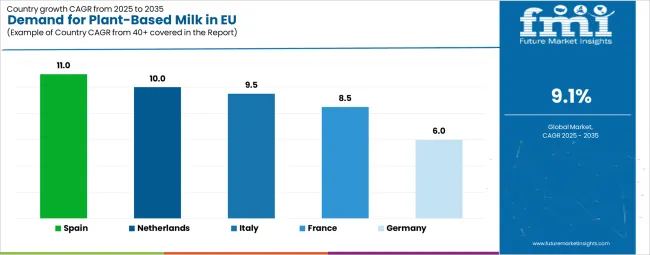
| Country | CAGR % |
|---|---|
| Spain | 11.0% |
| Netherlands | 10.0% |
| Italy | 9.5% |
| France | 8.5% |
| Germany | 6.0% |
EU plant-based milk sales demonstrate varying growth rates across major European economies, with Germany recording a 6.0% CAGR, France at 8.5%, Italy at 9.5%, Spain leading with 11.0%, and the Netherlands at 10.0% CAGR through 2035, driven by synchronized consumer trends toward flexitarian diets, environmental consciousness, and mainstream retail expansion of dairy alternatives. Germany maintains leadership through advanced vegan infrastructure and consumer acceptance, though growing at a more moderate pace reflecting maturity. France benefits from rapid adoption within a traditionally dairy-focused food culture, accelerating growth rates. Italy leverages growing health consciousness and dietary modernization, achieving strong growth momentum. Spain shows the strongest growth supported by the tourism industry's exposure to international food trends and expanding retail penetration. The Netherlands emphasizes sustainability credentials and premium organic positioning, maintaining robust double-digit growth. Overall, sales show differentiated regional development reflecting varying stages of plant-based adoption and cultural acceptance across EU member states.
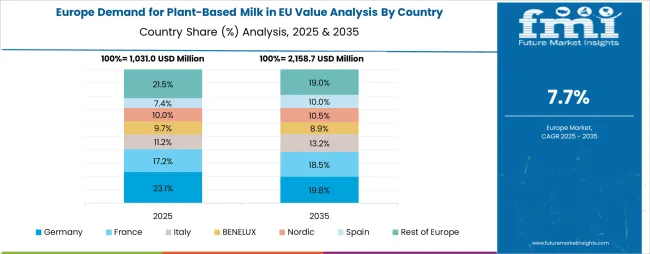
Revenue from plant-based milk in Germany is projected to exhibit robust growth with a CAGR of 6.0% through 2035, driven by exceptionally well-developed vegan food culture, comprehensive retail infrastructure for plant-based products, and strong consumer commitment to environmental sustainability throughout the country. Germany's sophisticated understanding of plant-based nutrition and internationally recognized leadership in vegan product innovation are creating substantial demand for diverse plant-based milk varieties across all consumer segments.
Major retailers, including Edeka, Rewe, Aldi, and specialized organic chains such as Alnatura, denn's Biomarkt, and Bio Company, systematically expand plant-based milk selections, often dedicating extensive refrigerated sections to dairy alternatives and positioning them prominently to encourage trial. German demand benefits from high environmental consciousness, substantial disposable income supporting premium organic products, and cultural openness to dietary innovation that naturally supports plant-based milk adoption across mainstream consumers beyond core vegan demographics.
Revenue from plant-based milk in France is expanding at a robust CAGR of 8.5%, substantially supported by evolving consumer attitudes toward dairy alternatives despite France's strong traditional dairy culture and cheese heritage. France's growing environmental consciousness among younger urban consumers and increasing lactose intolerance awareness are systematically driving demand for high-quality plant-based milk alternatives across diverse demographic segments.
Major retailers, including Carrefour, Auchan, Leclerc, and specialized organic chains, including Naturalia and Biocoop, gradually establish comprehensive plant-based milk ranges to serve the continuously growing demand. French sales particularly benefit from a sophisticated culinary culture that demands superior taste and quality standards, driving product innovation and premiumization within the plant-based milk category. Consumer education initiatives and professional chef endorsements are significantly enhancing penetration rates despite historical resistance to dairy alternatives in traditionally dairy-centric food culture.
Revenue from plant-based milk in Italy is growing at a consistent CAGR of 9.5%, fundamentally driven by increasing awareness of lactose intolerance prevalence, growing health consciousness, and gradual modernization of Italian dietary patterns to incorporate international food trends. Italy's traditionally dairy-heavy cuisine is gradually accommodating plant-based alternatives as consumers recognize the health benefits and environmental advantages of reducing dairy consumption.
Major retailers, including Coop Italia, Esselunga, Conad, and Carrefour Italia, strategically invest in plant-based milk category expansion and consumer education programs to address growing interest in dairy alternatives. Italian sales particularly benefit from a strong coffee culture that drives barista-grade product adoption in cafés and home preparation, creating multiple usage occasions supporting regular consumption. Tourism industry exposure to international dietary preferences and growing urban vegan communities in Milan, Rome, and other major cities contributes to expansion through cultural influence and mainstreaming of plant-based options.
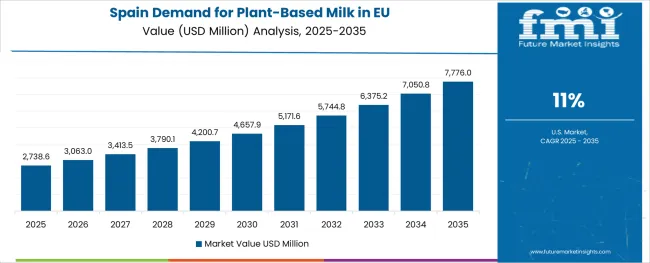
Demand for plant-based milk in Spain is projected to grow at a CAGR of 11.0%, substantially supported by tourism industry exposure to international dietary preferences, expanding retail availability through major supermarket chains, and increasing environmental awareness among younger Spanish consumers. Spanish food culture traditionally emphasizes fresh, natural ingredients, positioning plant-based milk as a natural evolution rather than a radical departure from culinary heritage.
Major retailers, including Mercadona, Carrefour España, Alcampo, and Lidl España, systematically expand plant-based milk offerings, with Mercadona's private-label plant-based products proving particularly successful in driving mainstream adoption through accessible pricing and prominent shelf placement. Spain's substantial tourism industry exposes domestic consumers to plant-based options through hotel breakfasts, café menus, and international restaurant chains, normalizing dairy alternatives and encouraging trial among curious consumers.
Demand for plant-based milk in the Netherlands is expanding at a CAGR of 10.0%, fundamentally driven by exceptionally strong environmental consciousness, leadership in sustainable food innovation, and comprehensive retail support for plant-based products across mainstream and specialized channels. Dutch consumers demonstrate particularly high receptivity to sustainability messaging and willingness to modify consumption patterns to reduce environmental impact.
Netherlands sales significantly benefit from a well-developed organic retail infrastructure, including Albert Heijn's extensive plant-based sections, Ekoplaza's specialized organic stores, and Marqt's premium positioning, combined with innovative food startups and established brands testing new products in a receptive Dutch environment. The country's dairy industry paradoxically coexists with growing plant-based adoption, as consumers increasingly recognize environmental contradictions and seek alternatives despite cultural dairy heritage. The Netherlands also serves as an innovation testing ground for European operations, with successful Dutch product launches often expanding to broader European activities.
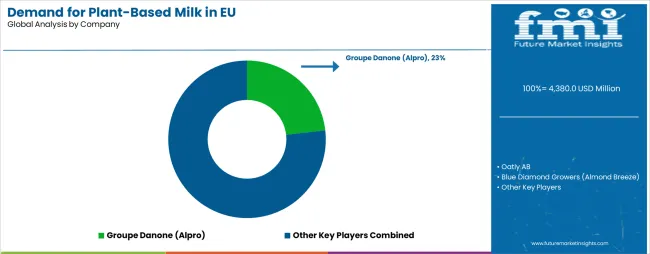
EU plant-based milk sales are defined by competition among multinational food companies, specialized plant-based brands, and regional producers. Companies are investing in taste and texture improvement technologies, nutritional fortification strategies, barista-grade product development, and sustainability communication to deliver high-quality, appealing, and environmentally responsible plant-based milk solutions. Strategic partnerships with coffee chains, retail expansion initiatives, and marketing campaigns emphasizing sustainability credentials are central to strengthening position.
Major participants include Groupe Danone with an estimated 15.0% share, leveraging its Alpro brand's established European presence, comprehensive product portfolio spanning multiple plant-based milk varieties, and extensive distribution relationships with major retailers and foodservice operators. Danone benefits from manufacturing scale, innovation capabilities, and the ability to support mainstream retail with consistent supply and promotional investment.
Oatly AB holds approximately 8.0% share, emphasizing distinctive brand positioning focused on sustainability messaging, barista-grade product excellence, and cultural marketing that resonates with environmentally conscious consumers. Oatly's success in the specialty coffee segment creates strong brand awareness and premiumization opportunities, though a limited product portfolio focused primarily on oat milk constrains overall share.
Blue Diamond Growers accounts for roughly 6.0% share through its Almond Breeze brand, leveraging a vertically integrated almond supply chain, established retail presence across European operations, and product variety spanning multiple flavor profiles and functional formulations. The company benefits from almond milk's premium positioning and strong consumer acceptance.
Nestlé S.A. represents approximately 6.0% share, supporting growth through manufacturing expansion, brand portfolio including Wunda pea-based milk and partnerships/acquisitions in the plant-based segment. Nestlé leverages distribution scale, innovation resources, and the ability to position plant-based milk alongside its traditional dairy portfolio in retail channels.
Other companies and regional brands collectively dominate with 65.0% share, reflecting the fragmented nature of European sales where numerous national brands, private label offerings from major retailers, and specialized organic producers serve local operations, niche segments, and specific consumer preferences. This fragmentation provides opportunities for differentiation through specialized ingredients (hemp, cashew, macadamia), organic certification, regional sourcing, and innovative flavors or functional benefits.
| Item | Value |
|---|---|
| Quantitative Units | USD 10,464.6 Million |
| Product Type | Soy Milk, Almond Milk, Oat Milk, Coconut Milk, Rice Milk, Others |
| Application/Use | Direct Beverage, Coffee/Barista, Culinary/Processing, Other |
| Distribution Channel | Supermarkets/Hypermarkets, Convenience Stores, Online Retail, Others |
| Nature | Organic, Conventional |
| Form | Liquid, Powder |
| Forecast Period | 2025-2035 |
| Base Year | 2025 |
| Historical Data | 2020-2024 |
| Countries Covered | Germany, France, Italy, Spain, the Netherlands, and the Rest of Europe |
| Key Companies Profiled | Groupe Danone (Alpro), Oatly AB, Blue Diamond Growers (Almond Breeze), Nestlé S.A., Regional brands |
| Report Pages | 180+ Pages |
| Data Tables | 50+ Tables and Figures |
| Additional Attributes | Dollar sales by product type, application/use, distribution channel, nature, and form; regional demand trends across major European operations; competitive landscape analysis with established players and emerging plant-based specialists; consumer preferences for organic versus conventional products; integration with sustainable agriculture practices and environmental certification programs; innovations in taste and texture optimization technologies; adoption of barista-grade formulations in specialty coffee segment; regulatory framework analysis for labeling and fortification requirements; supply chain optimization strategies; and penetration analysis for mainstream and environmentally conscious European consumers. |
The global demand for plant-based milk in EU is estimated to be valued at USD 4,380.0 million in 2025.
The market size for the demand for plant-based milk in EU is projected to reach USD 10,464.6 million by 2035.
The demand for plant-based milk in EU is expected to grow at a 9.1% CAGR between 2025 and 2035.
The key product types in demand for plant-based milk in EU are soy milk, almond milk, oat milk, coconut milk, rice milk and others.
In terms of application, direct beverage segment to command 60.0% share in the demand for plant-based milk in EU in 2025.






Our Research Products

The "Full Research Suite" delivers actionable market intel, deep dives on markets or technologies, so clients act faster, cut risk, and unlock growth.

The Leaderboard benchmarks and ranks top vendors, classifying them as Established Leaders, Leading Challengers, or Disruptors & Challengers.

Locates where complements amplify value and substitutes erode it, forecasting net impact by horizon

We deliver granular, decision-grade intel: market sizing, 5-year forecasts, pricing, adoption, usage, revenue, and operational KPIs—plus competitor tracking, regulation, and value chains—across 60 countries broadly.

Spot the shifts before they hit your P&L. We track inflection points, adoption curves, pricing moves, and ecosystem plays to show where demand is heading, why it is changing, and what to do next across high-growth markets and disruptive tech

Real-time reads of user behavior. We track shifting priorities, perceptions of today’s and next-gen services, and provider experience, then pace how fast tech moves from trial to adoption, blending buyer, consumer, and channel inputs with social signals (#WhySwitch, #UX).

Partner with our analyst team to build a custom report designed around your business priorities. From analysing market trends to assessing competitors or crafting bespoke datasets, we tailor insights to your needs.
Supplier Intelligence
Discovery & Profiling
Capacity & Footprint
Performance & Risk
Compliance & Governance
Commercial Readiness
Who Supplies Whom
Scorecards & Shortlists
Playbooks & Docs
Category Intelligence
Definition & Scope
Demand & Use Cases
Cost Drivers
Market Structure
Supply Chain Map
Trade & Policy
Operating Norms
Deliverables
Buyer Intelligence
Account Basics
Spend & Scope
Procurement Model
Vendor Requirements
Terms & Policies
Entry Strategy
Pain Points & Triggers
Outputs
Pricing Analysis
Benchmarks
Trends
Should-Cost
Indexation
Landed Cost
Commercial Terms
Deliverables
Brand Analysis
Positioning & Value Prop
Share & Presence
Customer Evidence
Go-to-Market
Digital & Reputation
Compliance & Trust
KPIs & Gaps
Outputs
Full Research Suite comprises of:
Market outlook & trends analysis
Interviews & case studies
Strategic recommendations
Vendor profiles & capabilities analysis
5-year forecasts
8 regions and 60+ country-level data splits
Market segment data splits
12 months of continuous data updates
DELIVERED AS:
PDF EXCEL ONLINE
Milk Pasteurization Machines Market Size and Share Forecast Outlook 2025 to 2035
Europe Calf Milk Replacer Market Outlook – Share, Growth & Forecast 2025–2035
Europe Human Milk Oligosaccharides Market Growth – Trends, Demand & Innovations 2025-2035
Demand for Fat Filled Milk Powder in EU Size and Share Forecast Outlook 2025 to 2035
Demand for Coconut Milk Products in the EU Size and Share Forecast Outlook 2025 to 2035
Demand and Trends Analysis of Fat Filled Milk Powder in Western Europe Size and Share Forecast Outlook 2025 to 2035
Milk Froth Thermometer Market Size and Share Forecast Outlook 2025 to 2035
Europe Radiotherapy Patient Positioning Market Size and Share Forecast Outlook 2025 to 2035
Europe Polyvinyl Alcohol Industry Analysis Size and Share Forecast Outlook 2025 to 2035
Milk Carton Market Size and Share Forecast Outlook 2025 to 2035
Europe Cruise Market Forecast and Outlook 2025 to 2035
Europium Market Forecast and Outlook 2025 to 2035
Milking Automation Market Size and Share Forecast Outlook 2025 to 2035
Eucommia Leaf Extract Market Size and Share Forecast Outlook 2025 to 2035
Europe Massage Therapy Service Market Size and Share Forecast Outlook 2025 to 2035
Europe Cement Market Analysis Size and Share Forecast Outlook 2025 to 2035
European Union Tourism Industry Size and Share Forecast Outlook 2025 to 2035
Europe Injection Molding Machines Market Size and Share Forecast Outlook 2025 to 2035
Europe Injection Moulders Market Size and Share Forecast Outlook 2025 to 2035
Europe and MENA Generic Oncology Drug Market Size and Share Forecast Outlook 2025 to 2035

Thank you!
You will receive an email from our Business Development Manager. Please be sure to check your SPAM/JUNK folder too.
Chat With
MaRIA